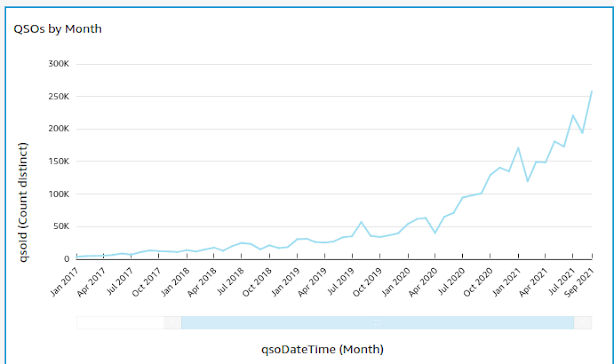When Antennas Attack
My most recent Parks on the Air (POTA) activation, an overnighter at Chino Hills State Park US-1139 on the weekend of 15 and 16 February, 2025, was a blast, but not without its challenges. During the evening hours, US Pacific time, I experienced a mysterious increase in SWR, and a resultant decrease in transmit power as my transmitter automatically rolled back the power to protect itself. It cost me at least one QSO, as I heard a station repeatedly trying to reply to my CQ with me unable to complete the exchange. As I like to say, I'm not a real engineer. I'm a graduate of a liberal arts school and a software engineer by trade. Someone more knowledgeable might be able to expand upon—or refute—my analysis of what happened. For now, here's what I think went wrong.
Background
Contest
The weekend in question was the weekend of the ARRL International DX Contest, CW. The CW portions of the non-WARC bands were wall to wall with contest participants, making frequency selection for POTA activators challenging.
A Visitor
During the afternoon of 15 February, US Pacific time, Endaf Buckley N6UTC dropped by for a visit and to get in his first activation of Chino Hills State Park. We operated on the phone portions of 10, 15, and 20 meters in two-operator mode, easily getting in the requisite ten contacts that included a couple of DX contacts with Australia and Japan. After Endaf left for the evening, I focussed primarily on making CW contacts.
No Low Bands
During the evening hours of 15 February, US Pacific time, I found the lowest HF bands to be dead, with zero contacts logged on 60 or 80 meters. Conditions were much better on 40 meters, with the aforementioned contest-related congestion on the CW portion.
Antenna
I was using a Palomar Engineers BAS-71 antenna, a 71-foot end-fed random wire with a 9:1 UNUN at the feed point. I've never had any problems with this antenna in the past, and consider it to be a good performer.
Tuning Procedure
When I tune, I usually reduce the power to five watts and set the SWR meter's power selector on the low power setting. I then find the combination of inductance and capacitance that gets the optimum SWR (I can almost always get it to 1.0) before returning the transmitter to 100 watts and selecting the higher power setting on the SWR meter.
What Happened
I operated on 40 meters CW on and off between 1930 and 2045 US Pacific time. Because of the congestion, I was on higher frequencies than I typically use in that band: 7089 kHz and 7195 kHz. After a few minutes of calling CQ, I noticed a steady rise in my SWR. I could literally see the reflected power increasing with each dit and dah on the code key, until the SWR was well over 3.0 and the transmitter started rolling back power. Retuning would usually help, but it would take a few minutes.
After a couple cycles of calling/SWR rise/retune, I took a few minutes to check the connections between my feed lines and my RF choke. When I returned to the rig from the connection check, the SWR had improved, but the problem repeated itself after a few minutes of calling CQ. I then lowered the feed end of the antenna from the mast to check the feed point connection, and noticed the UNUN was quite warm to the touch. I hoisted the feed end of the antenna back up the mast and noticed an improvement in SWR, followed by another degradation after a few minutes of calling CQ. At that point I called it a night, enjoyed a martini and some Cape Cod kettle chips, and turned in. The next morning I operated on 17 and 10 meters without incident, making numerous contacts that included three DX contacts in Europe.
Analysis
Possible Cause
While I don't fully understand the physics behind it, I suspect that I stumbled onto a portion of 40 meters where the UNUN wanted to convert the RF energy to heat, maybe in a way similar to how water likes to convert RF energy at around 2.45 GHz to heat. The UNUN heated to the point where it was no longer effectively transforming the antenna load. The relatively gradual increase in SWR could be attributed to the gradual heating of the UNUN. The apparent improvement after checking connections or retuning (at greatly reduced power) could be attributed to the time spent on those activities giving the UNUN time to cool. The lack of a problem on other bands, and the fact that I'd never used that particular antenna on that particular sliver of 40 meters supports the conclusion that the problem was frequency range specific.
Recommendations
Going forward, I'll avoid that portion of 40 meters when using the end-fed, or transmit in that range with less power. Planning overnight activations around popular contest weekends might also be a good strategy.
Conclusion
I think I learned something from all this. That's what amateur radio is all about.



Nice write up Ed! I saw your X post after Comp Radio reposted it. Good work with the EF random wire. What kind of mast did you use? A Spiderbeam orsomething similar to get that unun into the air? Keep up the good posts. - Tom
ReplyDeleteHi Tom. Glad you enjoyed the article. The mast is an MFJ-1918EX, which gets the UNUN about three meters off the ground.
Delete